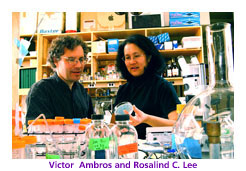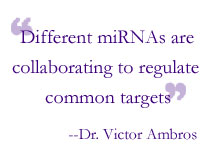
|
For Release: February 16, 2004
Contact: DMS Communications(603) 650-1492
Print Version
Small RNA Molecules Play Big Roles in Animal Development
HANOVER, NH--What a difference a decade makes! Just over 10 years ago DMS geneticist Victor Ambros, PhD, discovered a new RNA molecule, surprising in its ultra small size and unconventional activity. Today these tiny RNAs appear abundant and varied.

Unlike their larger, better known messenger RNA relatives, they do not code for proteins. Yet the potential of these short nucleotide chains in regulating animal development and behavior is far reaching, he reported at the American Association for the Advancement of Science (AAAS) annual meeting February 15 in Seattle.
The finding of that first little RNA (ribonucleic acid) which Ambros, professor of genetics, and Rosalind C. Lee, a research associate (working with Rhonda Feinbaum, a Harvard fellow), identified in a microscopic roundworm, was celebrated in the January 23 anniversary issue of Cell, which reviewed influential papers it published in its 30-year history.

Since that 1993 report, strides in technology have enabled scientists to document a panoply of genes for diverse mini RNAs. The AAAS deemed these new RNAs the 2002 breakthrough of the year and awarded Ambros and Lee, along with two other research teams, the AAAS Newcomb Cleveland Prize for their small RNA research, published in the journal Science.
Now, in a symposium at the 2004 annual AAAS meeting, Ambros highlighted work that continues to shed light on these modern RNAs and the critical roles they play in the expression of genetic information.
His recent studies of one class, called micro or miRNA in the C elegans worm, indicate that miRNAs function redundantly, meaning that miRNAs produced from different genes combine activity to regulate a common target. "In some cases one miRNA gene will become active at a certain time in development of the worm, then through a series of steps another miRNA becomes activated," he explained.
With its relatively simple genetic apparatus, C. elegans is a model study organism. The findings, said Ambros, illustrate principles that are probably applicable to all miRNAs: "That different miRNAs are collaborating to regulate common targets and that miRNAs will function in developmental control pathways to control sequences of events in tissues (where there's) extensive differentiation."
Another small RNA family is the small interfering RNA (siRNA) associated with gene silencing, where a gene essentially cancels itself by producing a double stranded RNA product. That silencing, or siRNA process, is distinct from the miRNA-based gene regulation where a gene is devoted to making a miRNA that then silences other genes to which it's partially complementary. "In the case of a micro RNA the gene is acting in a developmental context as part of the normal regulatory circuitry," Ambros said.
In normal worms hundreds of genes in the germ line--the cells with the traits inherited by each generation--are silenced. Ambros speculated these are genes whose level needs to be controlled and it's important for the biology of the germ line.
"Development of the germ line seems to involve widespread suppression of gene expression through this small RNA silencing mechanism. It is auto silencing, " Ambros said. "A diverse set of genes seems to be undergoing auto silencing to keep their own levels of expression low."
His team has found siRNAs that match normal genes. "This means that they're produced in the worms normally and are the agents for implementing the auto silencing. The small RNA is generated probably by the production of a double stranded RNA from the gene itself; so it's a negative feedback mechanism."
The big picture, Ambros said, stems from the stories of these little RNAs. With so many, for example, just in C. elegans, acting together or sequentially, many combinations can come into play in broad physiological and developmental contexts with considerable potential for gene regulation. Scientists can focus on these new gene families to answer key questions about heredity and development. The challenges escalate as the analyses become more complex, and the opportunities and answers become ever more exciting and wide ranging.
-DMS-